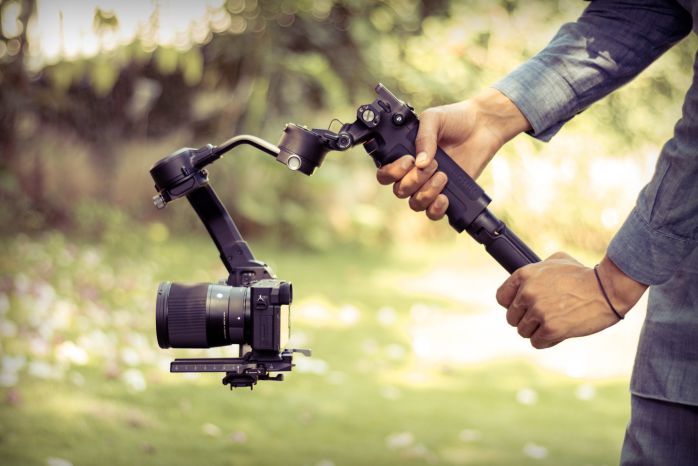If you are a keen photographer, you have already reached the level where you know the worth of a Camera stabilizer or gimbal. There is no need to brief you about how they are beneficial in shooting professional footage and how they compensate for all the unwanted quivering done by the camera while switching angles or scenes.
The only dilemma you would have been going through is which of the gimbals may suit you well.
When you take a look at the market, you will see how the up-to-date and advanced cameras have been wandering around, with different designs and different features, Like 2-axis and 3-axis Gimbal.
Choosing between these two potent two-axis and three-axis gimbal chaos is what we are talking about. They both are different, and they both are similar in certain ways; they both have that impeccable ability to shoot balanced professional shots, so which one will be better to pick. Study the major differences.
What is Gimbal?
Gimbals are an innovative handheld device that is used to compensate for the appearance of shakiness and quivering leading to the most balanced and professional streak of footage.
The gimbal majorly includes the engagement of intelligent sensors and upgraded motors to balance the moment caught during the switching angles or rotating camera. These are rapidly becoming essential for photography with the means to provide smooth, silky professional-level films.

The gimbals are differentiated on the basis of their three-axis; these axes are tilt, pan, and roll. Tilt which is also called pitch usually refers to the movement of upside and down during shooting, while the pan called Yaw subjectifies for the left and right movement.
The roll or Dutch is the biggest of all, which supports the shooting with an entire rotational angle, meaning you can target the subject with any unleveled angled rolling around-wise.
Two-Axis Gimbal
As stated by its name, Two-axis Gimbals are tools with the ability to stabilize the movement using a two-axis; Tilt and pan. This means the two-axis gimbal is beneficial in detecting and balancing movement through up and down transformation, much likely shaking your head; and the right to left changing. The two-axis gimbals are basically designed for the enthusiast with easy controls.
Three-Axis Gimbal
The Three-axis Gimbal, superior to the two-axis gimbal and the favorite of all, is ideally designed for the professional with a potent motor on each axis. Determining the name, the three-axis Gimbal uses three different axis tilt, pan, and roll to minimize the quivering and grant the most stable and balanced footage.
These gimbals are powerful enough to tolerate all the bumps and accidental jerking by moving up and down, left and right, and of course, rotation angling distance.
Difference between two-Axis and three-axis Gimbal
Even though they both do the same job of balancing the uneven quivering caught in the footage, they are precisely different from one another. they both get along with their different character and potential and are specified for a different level of shooting, obviously.
Coming to that significant point, let’s roll over to observe how the Two-axis Gimbals are different from the Three-axis gimbal based on the basic yet productive factors.

Stabilization– Comparing the both, we say the three-axis gimbal wins the round with its finest ability to sense the delicate movement and provide the smoothest stabilization. Also, these gimbals have the ability to immensely balance the unnecessary bumps coming in the way, giving assurance of full steadiness. This is not the same for the two-axis gimbal because of their less advancement.
Weight– The two-axis Gimbals are conveniently found lightest in weight than any of the three-axis gimbals, making things smoother and easier in transportation, storage, or holding it for the longest period. The three-axis gimbal’s extra third motor is responsible for putting extra weight, throwing a bulkier factor to its specification.
Durability– The two-axis might be sturdier, but it doesn’t even come closest to matching the immense durability Three-axis Gimbals have. The three-axis gimbal has this highly firm body trained to tackle the harsh weather climate scenario; they are also intended to have the longest-living potential than any of the two-axis gimbal’s body.
Performance– When it comes to performance, nothing can beat the three-axis Gimbal; because of its upgraded algorithm and extra motor, the stabilization operation has been justified to be the smoothest and fastest, which can be said the same for the two-axis gimbal as they failed to match the performance level of three-axis stabilizer.
Versatility – Clearly, the Three-axis Gimbal again won the round with its high versatility factor. Considering the name itself, the three-axis gimbal balances the unwanted quivering by Pan, Tilt, and Roll mechanism, while the two-axis gimbal does the same through only the axis Pan and Tilt. So turns out three-axis gimbals are significantly more versatile.
Size– Since the Three-axis Gimbal uses the three-axis stabilization mechanism with each motor on-axis, that signifies the complication in the engineering of its physical body. Nevertheless, two-axis gimbals have the most compact, convenient, and ergonomic design, granting users ease of holding.
Intelligence – As we said, the three-axis gimbal considerably had the most up-to-date algorithm. The modern potential, intelligent features (like Active track), and creative modes not only amused the photographer but also seized the artistic vibes in every shot. The Two-axis Gimbal, however, doesn’t come on the same road following the basic yet effective mechanism.
Price– Loaded with the all-creative potential, the three-axis Gimbal got to settle down with an expensive price tag worth every penny. However, for beginner and affordable purchases, the Two-axis Gimbal rocks the page with a pocket-friendly price tag.
Usage– The upgraded algorithm, enhanced intelligently, and other latest technology used in the three-axis gimbal makes it productive but also complicated to use. In contrast, the Two-axis gimbal came to have the simplest and most user-friendly controls.
Controls – The best part of all is the three-axis gimbal does associate with all the essential control in a single place; these controls are either configured at the physical body or engraved in the control ring. That’s not it; the gimbal also has a display panel for analyzing and modifying all the basic settings; the two-axis gimbal lacks this fruitful feature.
Power consumption– The power consumption is pretty different for both; the Three-axis Gimbal seems to consume a heavy dose of power because of its additional motor working; while the two-axis gimbal does settle with a stable usage of battery in order to grant you extended hours.
Two-Axis and Three-axis gimbal: Which is Best?
Based on the reading, you might have already figured out which gimbal is best and which one ideally suits your fit; still narrowing things down, we like to mention our thinking aspects.
So both the two-axis and three-axis gimbals have their different distinctive benefits. If you are a beginner or new to trying filming, you should go for the two-axis gimbal because of its easy controls, lightest weight, and the most affordable price.
Because you are trying gimbal, you don’t want to invest a lot of money in it. And also, the two-axis have the tilt and panning only, which doesn’t complicate things either.
However, the Gamechanger Three-axis Gimbal is the uttermost satisfaction if you are a professional or have expertise in shooting videography. The Three axis-gimbal is highly versatile with three-axis active stabilization.
It offers more sharpness, clarity, and balance, which cannot be said the same for the two-axis gimbal. The three-axis gimbals are even more convenient for traveling and dynamic shooting. These gimbals are also exquisitely fit for drones’ videography stuff.
Best Two-axis Gimbal
Zhiyun Smooth -X2 Gimbal- The lightest weightage, potent factor, and versatile gimbal come to weave your imagined professionalism in real footage and that too under. With the inspiration to be more than just a gimbal, it includes an extendable selfie stick up to 10 inches and a rotational tripod attachment, all under 0.67 pounds only.
The compact body of the gimbal is tiniest and foldable, making things easiest for storage. face and object tracking, slow motion, time-lapse, a lot can be done for at most three and half hours in a single charge with its 5000 mAh battery

Best Three-axis Gimbal
DJI- RSC 2 three Axis Gimbal Coming from a highly reliable brand with a compact design, amusing capability, and fascinating controls. The 2.65-pound body of the gimbal is easily transportable that can be folded into the size of A5 sheet paper.
With the ability to carry 6.6 pounds of payload, the gimbal provides super smooth stabilization with the strongest grip through the manfrotto Arca dual-layer mounting plate.
The gimbal has this exceptional 1-inch OLED display with essential controls and the 14 hours of battery runtime is absolutely stunning; all that artistic with numerous shooting modes on an affordable budget.
Final Words
Unless you want that jarring disruption to corrupt your hours of hard work, prevent the shaky motion that comes from holding a handheld camera; Use the almighty gimbal.
But you must already know, don’t you? Nevertheless, after going through the ultimate descriptive piece of difference measured between Two-axis and Three-axis Cameras, you have the insight to figure out what is best for you.
Considering the performance, the stabilization potential coverage, and the efficiency, we would like to go with three-Axis Gimbal here because of its versatility in stabilizing the movement with its three-axis and the other effective reasons.
But this is our point of view. Don’t forget to let us know what you think in the comment box below; till then, happy filming!




